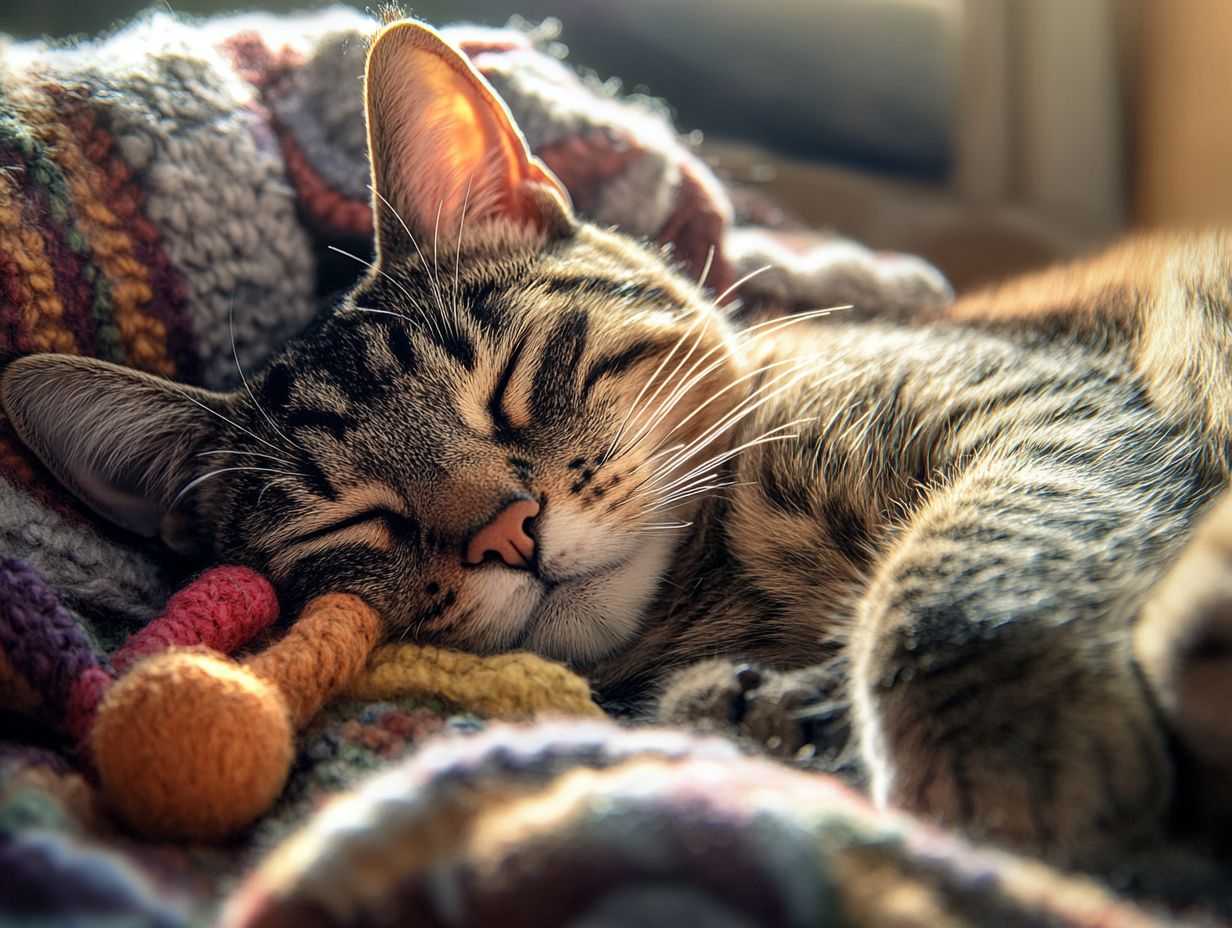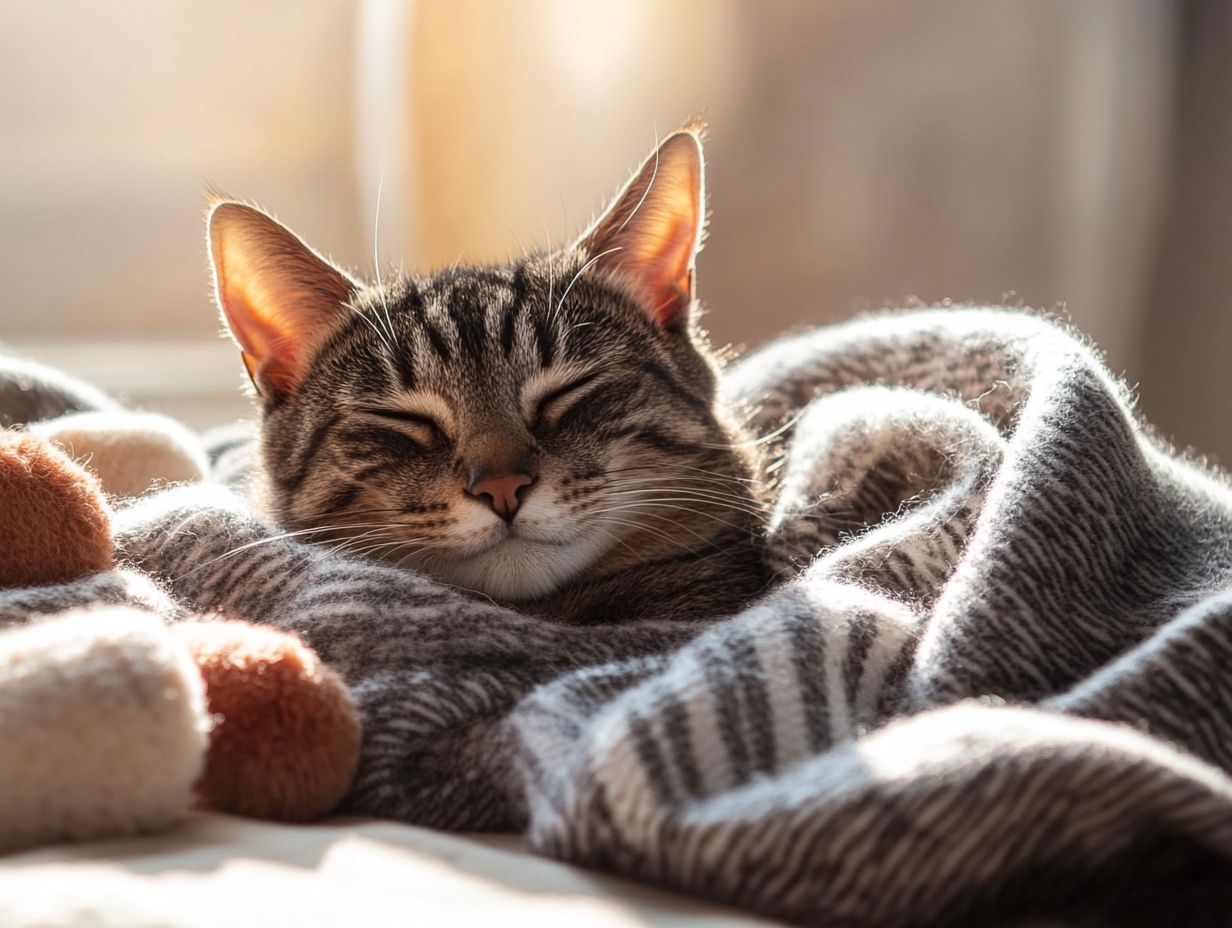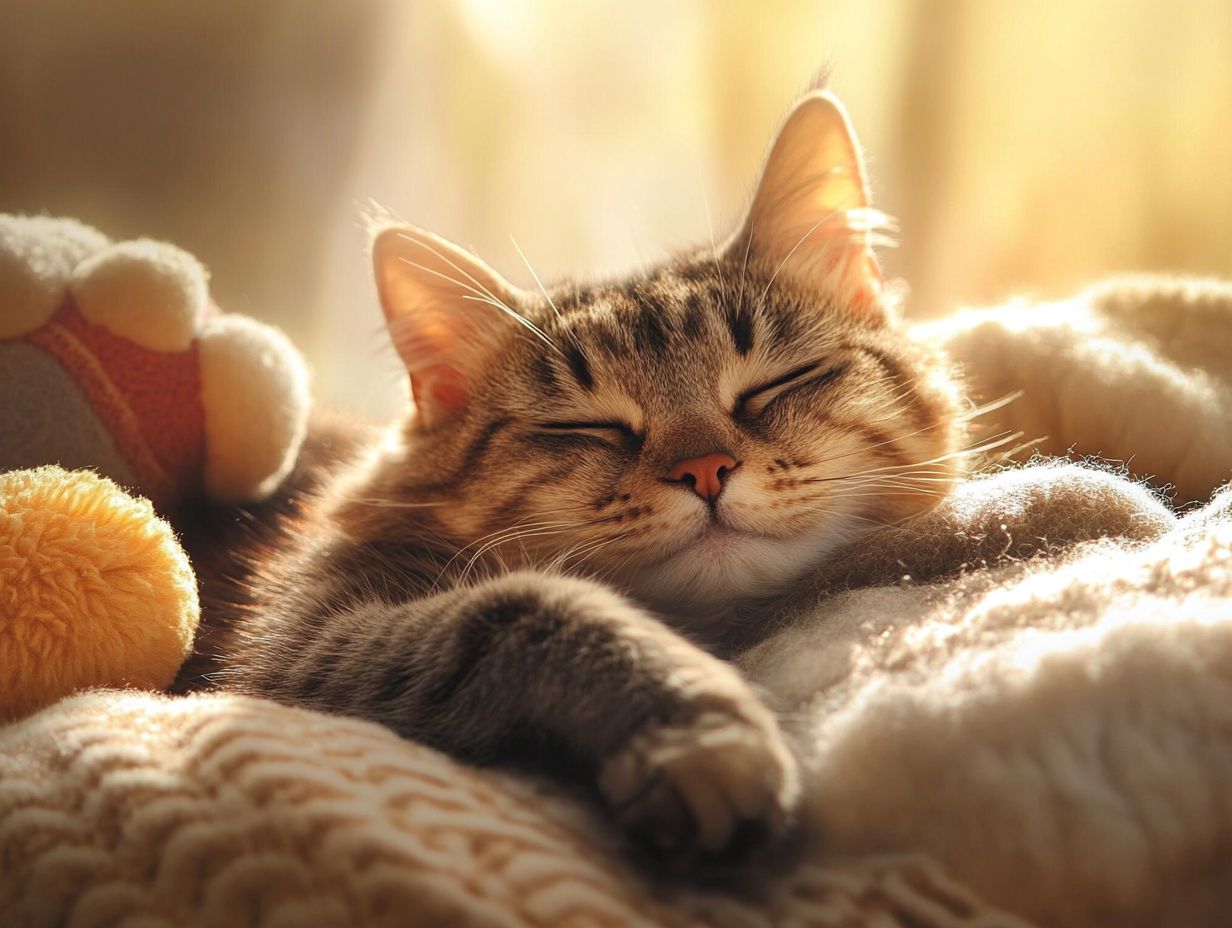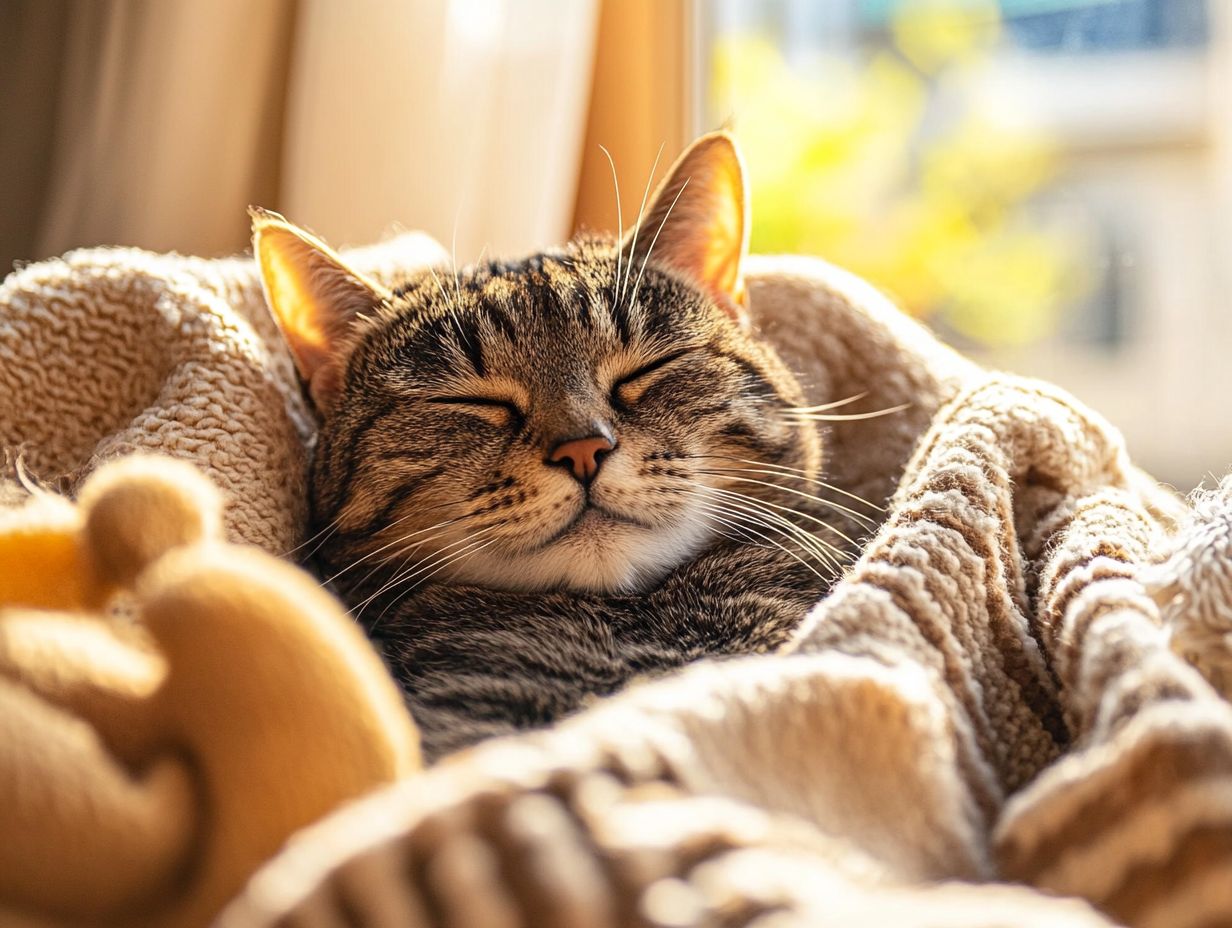Have you ever caught your cat looking at you and slowly closing its eyes? This charming behavior, often referred to as “slow blinking,” is more than just a cute quirk. It serves as a form of communication and can deepen the bond between you and your feline friend.
We will explore the reasons behind this endearing gesture, its meanings, and how you can use it to strengthen your relationship with your cat through effective communication.
Additionally, we will discuss when slow blinking might signal a need for concern and how to interpret these signals in your cat’s behavior. Remember, understanding a cat’s behavior can be complex and multi-faceted, influenced by environmental factors and individual cat history.
Join us as we uncover the fascinating world of cat communication!
Key Takeaways:

- Slow blinking is a form of communication for cats, expressing affection, trust, and love.
- It is also a way for cats to bond with their owners and feel relaxed and content.
- To strengthen the bond, practice slow blinking with your cat and give them space, respect, and positive reinforcement to make them feel happy and safe.
Why Do Cats Slow Blink?
Cats use a slow blink as a unique form of communication that reflects their emotional states and strengthens their bond with human companions. This behavior involves deliberately closing their eyes, which not only signifies trust but also serves as a gesture of affection, reinforcing the relationship between felines and their owners. Research indicates that understanding feline behavior can enhance our connection with them (source: peer-reviewed articles on feline communication).
Understanding this behavior can foster a deeper appreciation of the feline-human connection, ultimately contributing to a more harmonious living environment where both cats and their humans feel safe, comfortable, and happy.
1. Communication
Cats communicate in various ways, and slow blinking is one of the most significant methods they use to express their feelings to both people and other cats. This gentle gesture often symbolizes trust and affection, helping us better understand a cat’s emotional state.
When a cat slow blinks, it indicates that they feel safe and at home. They may also be more at ease making eye contact; if a cat is looking at you and blinking slowly, it’s a clear signal that they wish to connect.
Recognizing these subtle cues allows owners to better interpret their cat’s emotions. Fostering mutual understanding and respect contributes to the happiness of both, enhancing the overall relationship.
2. Bonding
Slow blinking in cats is regarded as a sign of bonding and affection, as it demonstrates their trust and love for their human owners. This subtle body language, often referred to as a “cat kiss,” plays a significant role in strengthening the bond between pet and owner.
When a cat slowly blinks, it indicates that the cat is relaxed and feels safe and comfortable in its surroundings. Pet owners can encourage this form of communication by slow blinking back at their cats, which often elicits positive responses such as purring, head bumps, or even a slow blink in return.
These interactions not only enhance the bond but also foster a sense of trust and companionship, ultimately deepening the emotional connection between them, making both the pet and the pet parents more content.
3. Relaxation
Cats typically slow blink when they feel comfortable and safe in their environment. This simple gesture indicates that the cat has a high level of trust in their human companions.
By softly closing their eyes, cats communicate their comfort and demonstrate that they feel secure. A relaxed cat will also exhibit a loose body posture, often sprawled out comfortably and perhaps even purring softly.
Creating a stress-free environment is essential for fostering these relaxed behaviors, as such surroundings promote positive body language in cats, allowing them to feel safe, secure, and comfortable enough to bond with their owners. Pay attention to factors that might influence this behavior, such as noise levels and the presence of other animals.
What Is the Meaning Behind Cat Slow Blinking?
The meaning of a cat’s slow blinking is conveyed through various emotional cues, including affection, trust, playfulness, and even submission. This makes it a complex and multi-faceted behavior.
1. Showing Affection

Slow blinking can vary among kittens, adults, and senior cats. Each developmental stage may display different emotional expressions. For instance, kittens may be more inclined to express affection through playfulness, whereas senior cats may slow blink to convey comfort and security.
Body Language
Common feline body language associated with slow blinking includes relaxed ears, a comfortable body posture, and a calm demeanor. Understanding these signals can help owners better interpret their cat’s feelings and enhance their interactions.
Encouraging Slow Blinking
Encourage slow blinking using positive reinforcement techniques, such as offering treats or praise when your cat blinks at you. This approach not only builds trust but also reinforces the bond between you and your feline friend.
Environmental Enrichment
Creating a stimulating environment with cozy spots or interactive toys can encourage slow blinking and other positive behaviors. Consider changes that might enhance your cat’s comfort, promoting relaxation and interaction.
Understanding Stress Factors
Environmental stressors can inhibit a cat’s ability to engage in slow blinking. If your cat appears reluctant to blink slowly, it may indicate discomfort or anxiety. Address potential underlying issues, such as noise or overcrowding, to help your cat feel more secure.
Common Misconceptions
It’s important to clarify that slow blinking is not the same as staring or hissing, which can indicate aggression or discomfort. Understanding these differences can improve your ability to interpret your cat’s behavior accurately.
Health Considerations
Certain health issues may affect a cat’s emotional state and their willingness to slow blink. Regular check-ups can help rule out medical causes affecting their behavior, ensuring their overall well-being.
Ongoing Learning
For more insights into feline behavior, consider reading materials or resources dedicated to cat communication. Continuous education can deepen your understanding of your cat’s needs and strengthen your bond.
Cats express feelings of comfort and trust through slow blinking, a natural behavior that signifies their emotional state. This subtle yet powerful form of body language indicates a strong emotional bond with their human companions, which is a reflection of their feelings towards them. When a cat engages in slow blinking, it offers a silent invitation to connect, demonstrating that they feel safe in that moment.
For many cat lovers, responding to this gesture can strengthen the bond, foster understanding, and enhance the emotional connection between both parties. Over time, these interactions can cultivate a deeper sense of companionship, allowing both feline and human to navigate their lives together with a shared sense of security and comfort. Research shows that a cat’s environment, including enrichment and safety, significantly influences their behavior and emotional well-being (ASPCA).
2. Trust and Comfort
Cats express trust and comfort through slow blinking, a gesture that signifies the strong emotional bond they share with their owners. This simple yet profound action clearly indicates the trust inherent in the feline-human relationship. When a cat slow blinks at someone, it signals that they feel comfortable and secure in that individual’s presence. This behavior acts as an invitation for further bonding, indicating that the cat views its owner as a trusted friend.
Observing a cat’s slow blinking can provide valuable insight into their emotional state, emphasizing the importance of a safe environment where they can thrive. In multi-cat households, this behavior may vary based on social dynamics, and understanding these interactions can help owners foster a harmonious environment.
3. Playfulness
Beyond expressing trust, slow blinking can signify a playful demeanor in cats, highlighting their unique personalities. This subtle behavior often serves as a bridge for interaction, signaling to their owners that it’s time for some lighthearted fun. When a cat engages in slow blinking, it is not merely a moment of relaxation but an invitation for connection and playfulness.
Understanding this behavior can strengthen the bond between the feline and their human. Recognizing the distinct personalities of cats enables owners to tailor their interactions, fostering an environment where playful exchanges can flourish. Suggesting safe toys or activities can stimulate a cat’s playful side, linking this back to slow blinking as a precursor to play.
These moments are essential, showcasing the joy and complexity of feline companionship.
4. Contentment
Contentment in cats is expressed through slow blinks, a behavior that signifies a relaxed and safe emotional state. This gentle gesture is often referred to as a “cat’s kiss”, as it represents a sign of affection and invites you into their serene world. When a cat closes its eyes slowly in your presence, they are expressing trust and comfort.
Cats frequently display this behavior while resting in a sunbeam or snuggling on a warm blanket next to you. Building a strong human-cat bond can reduce stress and anxiety, further linking it back to the significance of slow blinking in fostering comfort.
5. Sign of Submission
Slow blinking also serves as a sign of submission in cats, reflecting their awareness of social hierarchies. This behavior is commonly observed in the presence of other cats, where one cat may slowly blink at another to convey trust and reduce the likelihood of aggression. This non-verbal communication indicates to the other cat that the blinking cat does not pose a threat and acknowledges the higher status of the other cat.
How Can You Use Cat Slow Blinking to Bond with Your Cat?
Slow blinking can enhance your relationship with your cat by fostering trust and deepening your bond of connection.
1. Practice Slow Blinking with Your Cat

Slow blinking with your cat significantly enhances communication and strengthens your bond. This gentle behavior fosters trust, demonstrating to your cat that you are relaxed and non-threatening. To engage in this calming exercise, find a quiet spot where you can comfortably sit together with your cat. Begin by making eye contact, then slowly close your eyes for a few seconds before reopening them.
Be patient; your cat may not respond immediately, but with regular practice, you will foster a deeper connection. Ultimately, this bonding activity will help your cat feel more at ease in your presence.
2. Give Your Cat Space and Respect
Providing your cat with space and respecting their preferences fosters trust and mutual understanding of their needs. Each cat possesses a unique personality, and many may occasionally prefer solitude over interaction. Recognizing this preference allows them to feel safe and comfortable in their daily routine.
Understanding Feline Body Language
Slow blinking is just one aspect of feline body language. Combining it with other cues, such as tail position and ear orientation, can provide a holistic understanding of a cat’s emotions. Visual aids or diagrams can illustrate how these cues work together in communication.
Addressing Common Misunderstandings
Many owners misinterpret slow blinking, leading to behavioral issues. Understanding the context of this behavior can help prevent misunderstandings and promote a more positive relationship. If your cat appears hesitant to slow blink or shows signs of anxiety, consider providing a calming environment with safe spaces and familiar toys.
Seeking Professional Help
If a cat displays anxiety-related behaviors that inhibit slow blinking or other forms of communication, it may be time to seek professional help. Addressing these issues early can prevent further complications and promote a healthier emotional state.
Conclusion
Encouraging slow blinking can enhance your bond with your cat. By understanding feline emotions and behaviors, you can create an enriching environment that supports their well-being. Ongoing learning about feline behavior can deepen your understanding and strengthen your relationship. Consider reading books or exploring online resources dedicated to cat care and behavior.
Additionally, honoring their need for solitude creates an environment conducive to exploration and play when they choose. The more a cat trusts its owner, the more inclined they will be to seek companionship and engagement, ultimately strengthening the bond between them. Both physical and emotional health significantly impact feline behavior, influenced by environmental factors. For more insight into feline behavior, check out Why Do Cats Slow Blink? The Meaning Behind Cat Slow Blinking.
3. Use Positive Reinforcement
Using positive reinforcement techniques can increase the likelihood of your cat being more open to showing affection, including slow blinks. These methods encourage desired behaviors and foster greater trust between you and your cat. For instance, rewarding your cat with treats or praise when they exhibit affectionate behaviors, such as purring or cuddling, can reinforce these actions.
Over time, by recognizing patterns in your cat’s behavior, you can strengthen the bond of trust between you, creating a positive feedback loop. Eventually, your cat may recognize that certain behaviors yield positive outcomes, fostering a stronger friendship rooted in mutual respect. This relationship transforms into one characterized by absolute trust and love. Both owner and cat can learn to communicate effectively and understand each other’s feelings and behaviors.
When Should You Be Concerned About Your Cat’s Slow Blinking?
Although slow blinking is generally a positive sign in cats, there are instances when it may indicate underlying health or mental well-being issues. Experts like Gary Weitzman and Andy Sparkes emphasize the importance of recognizing these signs in their research on cat behavior.
1. Change in Behavior
A sudden change in your cat’s slow blinking behavior may signal emotional distress or other underlying issues. This alteration could indicate that your feline friend is experiencing anxiety or discomfort, making it crucial to monitor. According to studies published in the Journal of Feline Medicine and Surgery, such changes are key indicators.
Cats often use slow blinking as a form of communication, conveying trust and relaxation. A shift in this behavior may reflect stressors such as changes in their surroundings, the introduction of new pets, or even health problems. Observing their body language, including tail and whiskers movements, can provide additional insights into their emotional state.
Caregivers should learn to recognize these emotional cues to better understand when their pets may need extra support, ultimately promoting better overall health for their feline companions. Pet parents who pay close attention to their cat’s expressions and behaviors can foster a more trusting relationship.
Signs of Stress and Anxiety in Cats:
- Excessive grooming
- Hiding or withdrawal
- Changes in appetite
- Vocalization changes
- Destructive behavior
To help reduce stress, consider providing environmental enrichment through activities like interactive play, scratching posts, and safe hiding spots.
2. Medical Issues
Medical issues can impact a cat’s slow blinking behavior, making it important for pet parents to consult a veterinarian if they have concerns. Certain health problems, such as respiratory infections or dental pain, can influence how a cat expresses affection or discomfort. The American Association of Feline Practitioners recommends regular check-ups to monitor these issues.
For example, an underlying infection may reduce a cat’s likelihood of slow blinking as a form of communication. Pain or discomfort can lead to changes in baseline behaviors, so owners should be particularly observant. Notable changes accompanying slow blinking, such as a lack of appetite, lethargy, or altered eye movements, could indicate the need for a professional evaluation.
A veterinarian plays a crucial role in diagnosing these types of issues.
3. Aggression

In certain situations, slow blinking may be misinterpreted during aggressive encounters, so it is essential to observe the cat’s overall behavior. Slow blinking in cats is typically regarded as a sign of trust or affection, as felines have a complex system of communication. Studies, such as those in Scientific Reports, emphasize the importance of context in interpreting these signals.
However, in moments of stress or aggression, this slow blinking could be perceived as a challenge or a sign of submission, depending on the context. To avoid misunderstandings and promote effective communication among cats, it is important to consider all aspects of their behavior.
Further Learning Resources: For more information on feline behavior and health, visit reputable sources such as the American Association of Feline Practitioners or consult books by feline behaviorists.
Factors such as posture, tail position, and vocalizations should be evaluated alongside slow blinking to accurately assess a cat’s emotional state. Experts like Christine O’Brien, DVM (Feline Behavior Specialist) and Gary Weitzman, DVM (CEO of the San Diego Humane Society) suggest comprehensive observation of these behaviors for better understanding. According to Best Friends Animal Society, environmental enrichment significantly impacts these behaviors, confirming the need for a holistic perspective on feline emotions.
Frequently Asked Questions
Why Do Cats Slow Blink? – Insights from FELIWAY Optimum and Veterinary Healthcare Associates
Cats slow blink as a form of communication. It is a way for them to express affection and trust towards their owners or other cats. This behavior can be seen as a positive gesture, indicating their comfort level and emotional well-being.
The Meaning Behind Cat Slow Blinking – What Studies Reveal
Cat slow blinking can indicate feelings of contentment, relaxation, and happiness. Studies, such as those published in the Journal of Physiology, highlight these reactions as signs of a positive environment. However, individual variation exists among kittens, adults, and seniors, with each stage displaying distinct slow blinking behaviors.
What Does It Mean When a Cat Slow Blinks at You? – Understanding Feline Communication
When a cat slow blinks at you, it signifies a deep level of trust and comfort. This eye contact is a clear signal of their emotional state and personality. It is crucial to recognize that various breeds may exhibit this behavior differently; for instance, more social breeds like Ragdolls may slow blink more frequently than introverted breeds.
Do All Cats Slow Blink? – An Overview
Yes, most cats engage in slow blinking as a natural behavior. However, environmental factors and individual genetics may influence this tendency. For example, the North African wildcat, the ancestor of domestic cats, showcases this behavior, emphasizing its evolutionary significance.
Can You Slow Blink Back at Your Cat? – Strengthening Your Bond
Yes, you can slow blink back at your cat to show that you understand their message. This mutual understanding can foster a deeper relationship. Utilizing positive reinforcement, such as treats or praise, when engaging in this interaction can enhance the experience, while negative reinforcement may lead to confusion and stress.
Why Do Cats Slow Blink When They Are Sleepy? – Insights from Experts
Cats slow blink when they are sleepy to signal relaxation and trust. They feel safe enough to close their eyes in your presence. According to Tasmin Humphrey, DVM, this gesture is an essential part of their body language. Understanding this can help locate the right environment for fostering this behavior.
Understanding Multi-Cat Households and Slow Blinking Variability
In multi-cat households, slow blinking may vary among different cats. Recognizing each cat’s unique personality and stress responses can aid in understanding their communication. Signs of stress and anxiety, such as the absence of slow blinking, may indicate underlying issues that need addressing.
Ethical Considerations and Fostering Positive Emotional States
Encouraging natural behaviors like slow blinking should be approached ethically, respecting the cat’s autonomy. Preventive strategies, such as providing safe activities and environmental enrichment, can enhance cats’ emotional states and encourage slow blinking.
Signs of Stress and Anxiety in Cats
Being aware of signs indicating stress and anxiety is crucial, as these can inhibit slow blinking. If a cat is not engaging in slow blinking, it may be necessary to evaluate their emotional well-being and consider seeking assistance from a veterinarian or animal behaviorist.
Practical Applications for Bonding with Your Cat
To strengthen your bond with your cat, try initiating slow blinking through gentle eye contact. Start with a soft gaze, gradually closing your eyes slowly. This step-by-step technique fosters a safe and trusting environment for your feline friend.
Further Resources for Deeper Knowledge
For more insights into feline behavior, consider exploring resources such as books on cat behavior by John Bradshaw or online platforms dedicated to animal behavior. Ongoing learning can deepen your understanding of your cat’s unique communication style.